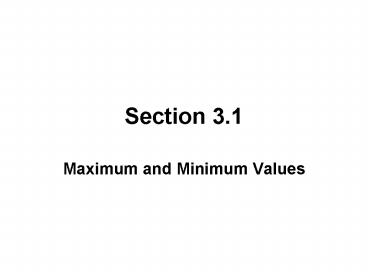Maximum and Minimum Values - PowerPoint PPT Presentation
1 / 9
Title:
Maximum and Minimum Values
Description:
Section 3.1 Maximum and Minimum Values ABSOLUTE MINIMUM AND ABSOLUTE MAXIMUM A function f has an absolute (or global) maximum at c if f (c) f (x) for all x in D ... – PowerPoint PPT presentation
Number of Views:403
Avg rating:3.0/5.0
Title: Maximum and Minimum Values
1
Section 3.1
- Maximum and Minimum Values
2
ABSOLUTE MINIMUM AND ABSOLUTE MAXIMUM
- A function f has an absolute (or global) maximum
at c if f (c) f (x) for all x in D, where D
is the domain of f. The number f (c) is called
the maximum value of f on D. - A function f has an absolute (or global) minimum
at c if f (c) f (x) for all x in D, where D
is the domain of f. The number f (c) is called
the minimum value of f on D. - The maximum and minimum values of f are called
the extreme values of f.
3
LOCAL MINIMUM ANDLOCAL MAXIMUM
- A function f has a local (or relative) maximum
at c if f (c) f (x) for all x near c. - A function f has a local (or relative) minimum
at c if f (c) f (x) for all x near c.
4
THE EXTREME VALUE THEOREM
Theorem If f is continuous on a closed
interval a, b, then f attains an absolute
maximum value f (c) and an absolute minimum
value f (d) at some numbers c and d in a, b.
5
FERMATS THEOREM
Theorem If f has a local maximum or minimum
at c, and if f '(c) exists, then f '(c) 0.
6
CRITICAL NUMBERS
A critical number of a function f is a number c
in the domain of f such that either f '(c) 0 or
f '(c) does not exist.
7
FERMATS THEOREM REVISITED
Fermats Theorem can be stated using the idea of
critical numbers as follows. Fermats Theorem
If f has a local minimum or local maximum at c,
then c is a critical number of f.
8
THEOREM
If f is continuous on a closed interval a, b,
then f attains both an absolute minimum and
absolute maximum value on that interval.
9
THE CLOSED INTERVAL METHOD
To find the absolute maximum and minimum values
of a continuous function on a closed interval a,
b
- Find the values of f at the critical numbers of f
in (a, b). - Find the values of f at the endpoints of the
interval. - The largest of the values from Steps 1 and 2 is
the absolute maximum value the smallest of these
values is the absolute minimum value.































